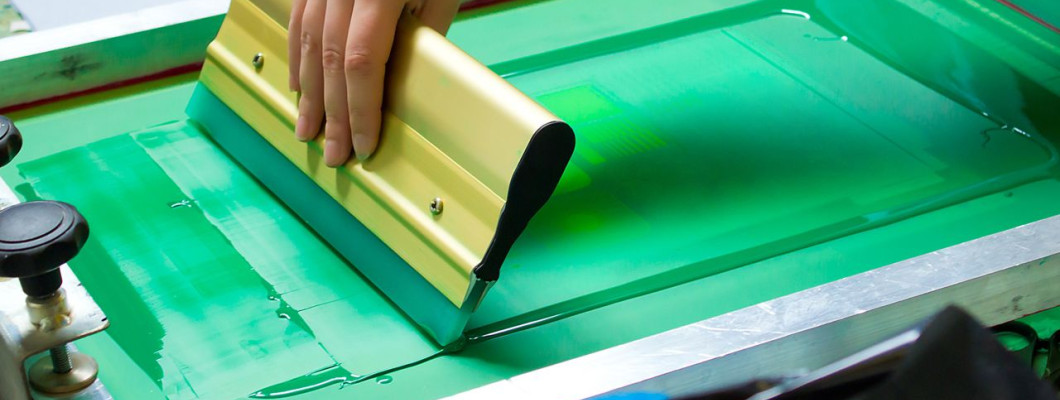
What is Screen Printing?
Definition and Characteristics
Screen printing is a printing method that uses a fine mesh fabric as a matrix to transfer ink onto a surface. Unlike other techniques, such as digital printing or lithography, screen printing allows for opaque and highly covering colors, ideal for projects that require a high visual impact.
History of Screen Printing
Ancient Origins
The origins of screen printing date back over a thousand years, with the first forms of stencil printing used in China during the Song Dynasty (960-1279 AD). The technique then spread to Japan and other Asian countries, where it was used to decorate fabrics and create works of art.
Screen Printing in the 20th Century
In the 20th century, screen printing conquered the Western world, becoming one of the preferred techniques of artists like Andy Warhol, who made it famous with his iconic pop art works. Today, screen printing is used not only in art but also in the textile industry, advertising, and even in the production of electronic components.
Materials Needed to Start Screen Printing
To get started with screen printing, you don’t need overly complex equipment. Here’s a list of essential materials:
- Stretched Screens – made of wood or metal and covered with a polyester mesh to transfer the design.
- Photosensitive Emulsion – applied to the polyester mesh of the screen to create areas permeable to ink.
- Inks – such as water-based inks (eco-friendly) or plastisol inks (highly performant).
- Scoop Coater – for evenly distributing the emulsion on the screen mesh.
- Squeegee – a tool for evenly spreading the screen printing ink.
Choosing the right materials is essential for achieving professional results. In the following paragraphs, we will guide you through each step of the process, offering useful tips for screen printing.
One of the strengths of screen printing is its versatility. It can be used on:
- Fabrics: t-shirts, sweatshirts, bags, cushions.
- Paper: posters, illustrations, business cards.
- Other materials: wood, glass, plastic, metal.
How Does Screen Printing Work?
1. Prepare the Design
Before starting, it’s important to prepare the design. Create the design digitally using graphic software or draw it by hand, then transfer it to specific films using laser or inkjet printers. Ensure the design is sharp and uses solid black as the only color.
2. Expose the Screen (Frame)
For precise printing, it’s essential to use a high-quality stretched screen. Apply the photosensitive emulsion to the mesh using an emulsion coating trough. Expose the screen to UV light with the prepared film placed on top to create areas permeable to ink.
3. Apply the Ink
After preparing the screen, it’s time to apply the ink. Place the screen over the material to be printed and, with the right pressure, use the squeegee to spread the ink evenly. Ensure the entire design is covered with a uniform layer of ink.
4. Drying and Finishing
Once the printing is complete, let the material dry in a well-ventilated area. Depending on the type of ink used, complete drying may take several hours. To increase the durability of the print, you can heat-set it using a screen printing oven or a high-temperature heat gun.
5. Cleaning the Tools
After printing, it’s important to thoroughly clean the screen and squeegee to remove any ink residue. Proper maintenance of the tools ensures they can be reused without issues for future projects.

Materials and Equipment for Screen Printing
Stretched Screens
Stretched screens are one of the fundamental elements of screen printing. They can be made of wood or metal and must be covered with a high-quality polyester mesh to ensure precise results.
Photosensitive Emulsion
The emulsion is applied to the polyester mesh of the screen and, once exposed to UV light, creates areas permeable and impermeable to ink.
Inks
There are different types of screen printing inks:
- Water-based inks: eco-friendly and ideal for light fabrics.
- Plastisol inks: more durable and suitable for dark fabrics.
- Special inks: metallic, glitter, or fluorescent.
Emulsion Coating Trough
This tool is essential for evenly distributing the emulsion on the screen mesh.
Squeegee
The squeegee is used to spread the ink through the mesh and transfer the design onto the surface.
Advantages of Screen Printing
Superior Quality
The colors are vibrant, opaque, and resistant over time, ideal for projects that require a high visual impact.
Versatility
It can be used on a wide range of materials and surfaces, making it suitable for multiple applications.
Customization
Ideal for small or large-scale productions, with the possibility of creating unique pieces.
Durability
Screen prints are resistant to wear and washing, especially on fabrics.
Applications of Screen Printing
Fashion and Apparel
Screen printing is widely used for printing on t-shirts, sweatshirts, bags, and accessories. Thanks to plastisol inks, prints on fabrics are particularly durable and long-lasting.
Art and Design
Artists and designers use screen printing to create posters, illustrations, and unique works of art.
Advertising and Marketing
Ideal for producing signs, banners, and promotional materials.
Electronics
Screen printing is also used in printing circuits and electronic components.

Why Choose Screen Printing?
Excellence in Quality
Screen printing offers superior results compared to other printing techniques, with bright colors and long-lasting prints.
Suitable for Every Project
Whether you want to create a unique work of art or produce a personalized design in series, screen printing is the perfect choice.
Eco-Friendly
It uses water-based inks, an eco-friendly solution that reduces environmental impact compared to traditional inks.
Contact Us to Learn More
Are you interested in learning more about screen printing or want to start a personalized project? Don’t hesitate to contact us! Our team of experts is here to help you turn your ideas into reality.
Conclusion
Screen printing is a simple yet effective technique for customizing fabrics, paper, and other materials with style. Whether you’re creating t-shirts, posters, or accessories, by following these steps, you can achieve professional results right at home.

Leave a Comment